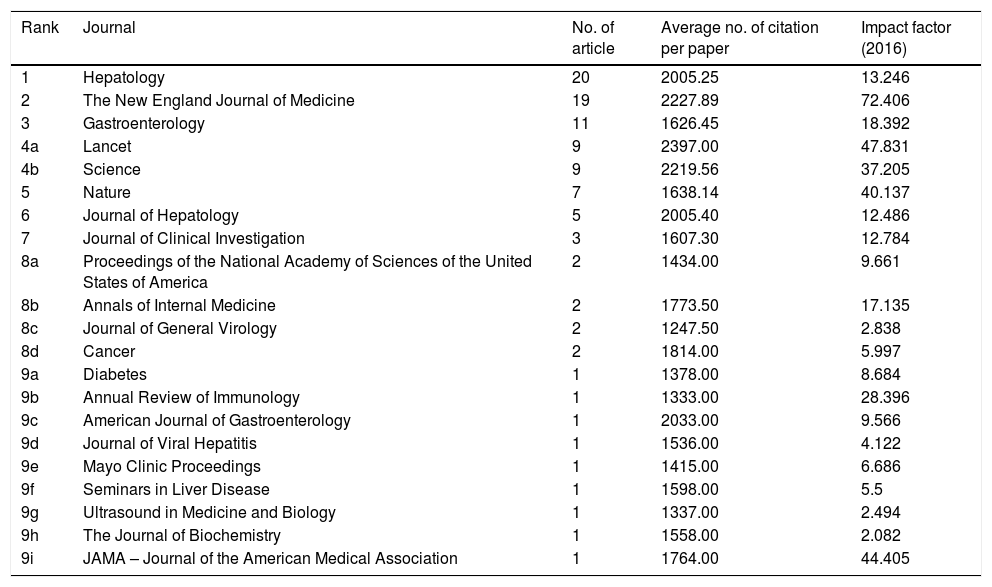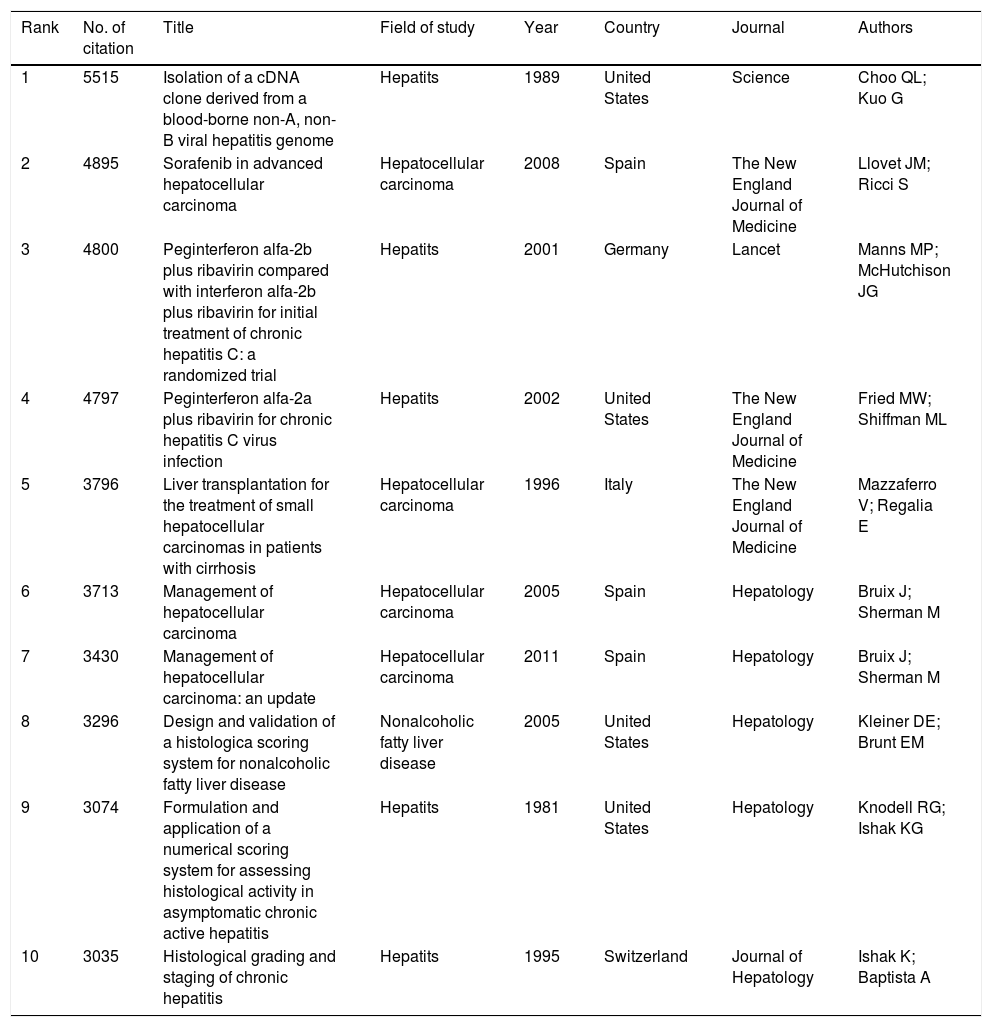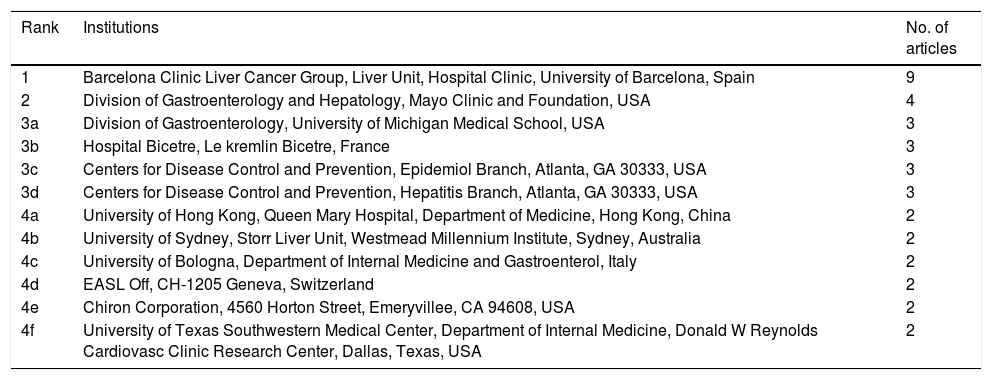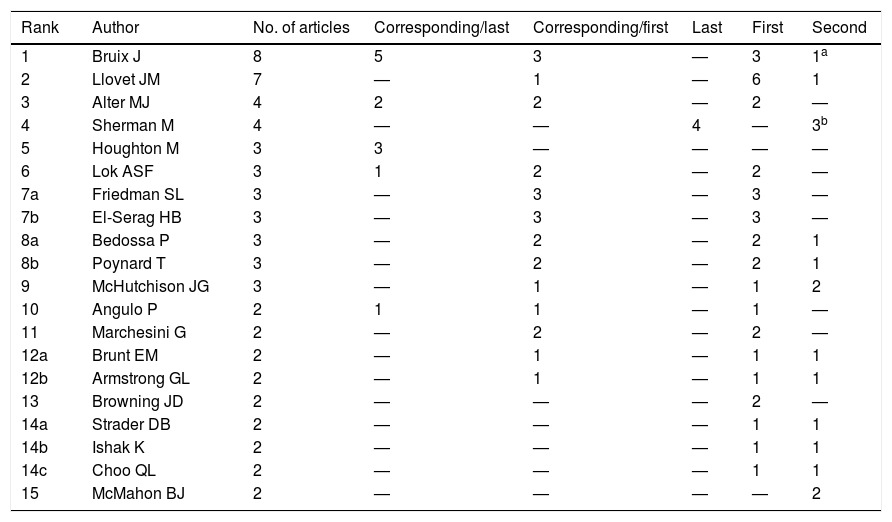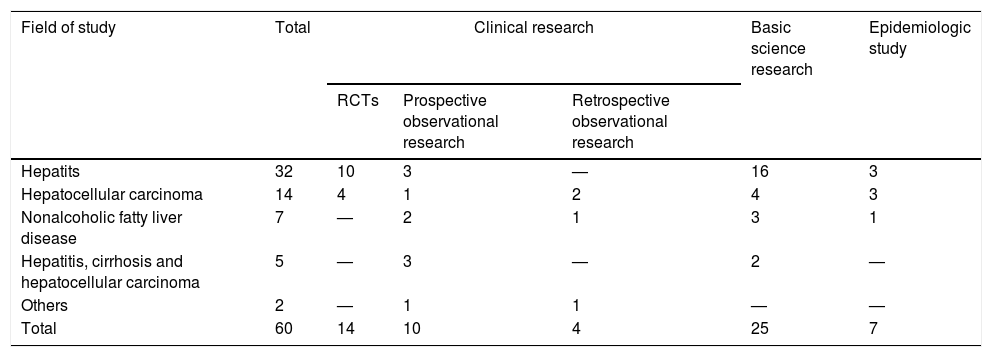Bibliometric search of citation classics can function as a tool to identify extraordinary landmark articles and advanced research studies. We aimed to examine and characterize the 100 most-cited published articles in the field of hepatology.
Patients and methodsA comprehensive list of the 100 most-cited articles published from 1950 to 2017 in the field of hepatology was compiled after searching the Web of Science with relevant terms, including “liver,” “hepatitis,” “hepatic,” “hepatocellular,” “hepatology,” “cirrhosis,” and “steatohepatitis.” The articles were ranked according to their citation counts and were evaluated for characteristics including country, institution, authorship, publication year, subspecialty and others.
ResultsThe database search returned 323,291 articles associated with liver disease published between 1950 and 2017. The 100 most-cited articles were from 21 major journals, with the highest number of articles being published in Hepatology (n=20). The average number of citations of the 100 most-cited articles was 1946.8; among these articles, the most frequently cited article received 5515 citations, and the least frequently cited article received 1155 citations. In total, 60 were original articles among the 100 most-cited articles. The most frequently represented specialties were hepatitis, hepatocellular carcinoma, and nonalcoholic fatty liver disease, which accounted for 53.3%, 23.3%, and 11.7% of these articles, respectively.
DiscussionOur study identified citation classics and provided a review of the most advanced studies in the field of hepatology. This can help to guide clinical treatment and future academic research resulting in advancements in hepatology.
La búsqueda bibliométrica de clásicos en materia de citaciones puede funcionar como una herramienta para identificar artículos extraordinarios de interés y estudios de investigación avanzada. Nos propusimos examinar y caracterizar los 100 artículos publicados más citados en el ámbito de la hepatología.
Pacientes y métodosSe recabó una lista exhaustiva de los 100 artículos más citados en el ámbito de la hepatología publicados entre 1950 y 2017, tras realizar una búsqueda en la Web of Science con términos relevantes, como «hígado», «hepatitis», «hepático», «hepatocelular», «hepatología», «cirrosis» y «esteatohepatitis». Los artículos se clasificaron de acuerdo con el número de citas y se evaluaron en función de características como el país, la institución, la autoría, el año de publicación, la subespecialidad y otras.
ResultadosLa búsqueda en la base de datos dio como resultado 323.291 artículos relacionados con enfermedades hepáticas publicados entre 1950 y 2017. Los 100 artículos más citados procedían de 21 revistas importantes, y el mayor número de artículos se había publicado en Hepatology (n=20). El promedio de citaciones de los 100 artículos más citados fue de 1.946,8; entre estos artículos, el artículo citado con más frecuencia se citó en 5.515 ocasiones, y el artículo citado con menor frecuencia recibió 1.155 citas. En total se encontraron 60 artículos originales entre los 100 artículos más citados. Las especialidades representadas con mayor frecuencia fueron hepatitis, carcinoma hepatocelular y esteatosis no alcohólica, que representaban el 53,3, el 23,3 y el 11,7% de estos artículos, respectivamente.
DiscusiónEn nuestro estudio se identificaron los clásicos en materia de citaciones y se proporcionó una revisión de los estudios más avanzados en el campo de la hepatología. Esto puede ayudar a guiar el tratamiento clínico y las futuras investigaciones académicas y derivar en avances en la hepatología.
The development of convenient electronic access to medical literature has resulted in an information redundancy that requires physicians to improve their ability to quickly identify important articles associated with their specific interests and fields.
The citations received by an article play an important role in disseminating current knowledge. They are regarded as a symbol of the scholarly achievements of countries, journals, and authors, and to some extent, they reflect how the scientist's peers view their contributions to specific fields. Citation count has been used to measure the quality of research studies on a national scale.1 Articles with higher citation counts are of greater value to other researchers and appear to have greater impact on the scientific community.2 Thus, citation analysis can function as a reliable tool to identify the most influential articles in a specific field.
Recently, several studies have been performed to analyze high-citation articles in the fields of anesthesiology,3 acute pancreatitis 4and others. Although there has been bibliometric analysis of high-citation articles in the field of nonalcoholic fatty liver disease,5 liver transplantation,6 transient elastography,7 and hepatocarcinoma,8 they are merely based on a certain subspecialty of hepatology. Bibliometric analysis of high-citation articles evaluating the whole field of hepatology remains unknown. Therefore, this study aimed to identify and analyze the 100 most-cited articles in the field of hepatology to understand the historical perspective and to promote discussion and scientific progress in this specialty.
Materials and methodsWe compiled a list of the 100 most-cited articles regarding hepatic diseases published from 1950 to 2017. On searching the Institute for Scientific Information (ISI) Web of Knowledge, which includes the Science Citation Index Expanded, we obtained a list of articles ranked according to citation count in descending order. All searches were conducted on September 27, 2017 to prevent changes in citation times, which may influence data accuracy. The subject terms for article retrieval from the database were “liver*,” “hepatitis*,” “hepatic*,” “hepatocellular*,” “hepatology*,” “cirrhosis*,” and “steatohepatitis*,” with asterisks indicating wild cards. Because the full texts of several articles are unavailable online, the titles, keywords, and abstracts of the 100 most-cited articles were evaluated individually by three researchers (Qiuyu Yu, Manrong He, and Yuang Ren), and the results were compared to minimize the influence of personal bias on the results. To ensure that the articles are relevant to liver disease, irrelevant articles were eliminated after careful scrutiny. For example, articles focusing on the pathomorphology of the liver were eliminated, whereas articles focusing on the pathomechanism of hepatic diseases were included. If articles had more than two authors, only the first, second and corresponding authors were included. The top 100 articles were selected, and all the relevant data were collected and input into Excel 2010 (Fig. 1) by one researcher (Yan Peng). Further, all data were collated and analyzed by two researchers (Xiangsheng Fu and Xiaowei Tang) according to the country, institution, journal, authorship, publication year, topic, type, and study design. The authors are ranked according to the number of articles they are authored or coauthored. If the number of articles is same between two individuals, then we rank them according to the number of their articles as corresponding/last authors, corresponding/first authors, last authors, first authors and second authors in sequence. Country of origin is based on the nationality of the first author. Descriptive statistics were used to characterize the data. Finally, the article was written by two researchers (Shali Tan and Qiuyu Yu).
ResultsIn total, 323,291 articles relevant to liver disease were cited more than 100 times in the ISI Web of Knowledge during the study period. The 100 most-cited articles are listed in Table S1 in descending order according to the number of their citations. The average citation count of these articles was 1946.8; the most frequently cited article9 received 5515 citations, and the least frequently cited article10 received 1155 citations since publication.
Publication years and journals of the most-cited articlesAmong the 21 major journals that published the 100 most-cited articles, Hepatology published the highest number of articles (n=20), followed by the New England Journal of Medicine (n=19), Gastroenterology (n=11), Lancet (n=9), Science (n=9), Nature (n=7), the Journal of Hepatology (n=5), and the Journal of Clinical Investigation (n=3). Twelve journals (57%) published two or more articles (Table 1).
Journals in which the top 100 cited hepatic disease articles were published.
| Rank | Journal | No. of article | Average no. of citation per paper | Impact factor (2016) |
|---|---|---|---|---|
| 1 | Hepatology | 20 | 2005.25 | 13.246 |
| 2 | The New England Journal of Medicine | 19 | 2227.89 | 72.406 |
| 3 | Gastroenterology | 11 | 1626.45 | 18.392 |
| 4a | Lancet | 9 | 2397.00 | 47.831 |
| 4b | Science | 9 | 2219.56 | 37.205 |
| 5 | Nature | 7 | 1638.14 | 40.137 |
| 6 | Journal of Hepatology | 5 | 2005.40 | 12.486 |
| 7 | Journal of Clinical Investigation | 3 | 1607.30 | 12.784 |
| 8a | Proceedings of the National Academy of Sciences of the United States of America | 2 | 1434.00 | 9.661 |
| 8b | Annals of Internal Medicine | 2 | 1773.50 | 17.135 |
| 8c | Journal of General Virology | 2 | 1247.50 | 2.838 |
| 8d | Cancer | 2 | 1814.00 | 5.997 |
| 9a | Diabetes | 1 | 1378.00 | 8.684 |
| 9b | Annual Review of Immunology | 1 | 1333.00 | 28.396 |
| 9c | American Journal of Gastroenterology | 1 | 2033.00 | 9.566 |
| 9d | Journal of Viral Hepatitis | 1 | 1536.00 | 4.122 |
| 9e | Mayo Clinic Proceedings | 1 | 1415.00 | 6.686 |
| 9f | Seminars in Liver Disease | 1 | 1598.00 | 5.5 |
| 9g | Ultrasound in Medicine and Biology | 1 | 1337.00 | 2.494 |
| 9h | The Journal of Biochemistry | 1 | 1558.00 | 2.082 |
| 9i | JAMA – Journal of the American Medical Association | 1 | 1764.00 | 44.405 |
Among the 100 most-cited articles, the earliest was published in Cancer in early 1954 by Edmondson,11 with 2163 citations. The latest was published in the Journal of Hepatology in 2012,12 with 1164 citations.
The majority of the 100 most-cited articles (81%) were published between 1995 and 2010; 62% were published after 2000, with the highest number of articles (n=11) published in 2005 (Fig. 2). Among the 10 most-cited articles, the average citation count was 4035.1; these articles were published between 1981 and 2011 (Table 2).
The top 10 cited papers in hepatic disease.
| Rank | No. of citation | Title | Field of study | Year | Country | Journal | Authors |
|---|---|---|---|---|---|---|---|
| 1 | 5515 | Isolation of a cDNA clone derived from a blood-borne non-A, non-B viral hepatitis genome | Hepatits | 1989 | United States | Science | Choo QL; Kuo G |
| 2 | 4895 | Sorafenib in advanced hepatocellular carcinoma | Hepatocellular carcinoma | 2008 | Spain | The New England Journal of Medicine | Llovet JM; Ricci S |
| 3 | 4800 | Peginterferon alfa-2b plus ribavirin compared with interferon alfa-2b plus ribavirin for initial treatment of chronic hepatitis C: a randomized trial | Hepatits | 2001 | Germany | Lancet | Manns MP; McHutchison JG |
| 4 | 4797 | Peginterferon alfa-2a plus ribavirin for chronic hepatitis C virus infection | Hepatits | 2002 | United States | The New England Journal of Medicine | Fried MW; Shiffman ML |
| 5 | 3796 | Liver transplantation for the treatment of small hepatocellular carcinomas in patients with cirrhosis | Hepatocellular carcinoma | 1996 | Italy | The New England Journal of Medicine | Mazzaferro V; Regalia E |
| 6 | 3713 | Management of hepatocellular carcinoma | Hepatocellular carcinoma | 2005 | Spain | Hepatology | Bruix J; Sherman M |
| 7 | 3430 | Management of hepatocellular carcinoma: an update | Hepatocellular carcinoma | 2011 | Spain | Hepatology | Bruix J; Sherman M |
| 8 | 3296 | Design and validation of a histologica scoring system for nonalcoholic fatty liver disease | Nonalcoholic fatty liver disease | 2005 | United States | Hepatology | Kleiner DE; Brunt EM |
| 9 | 3074 | Formulation and application of a numerical scoring system for assessing histological activity in asymptomatic chronic active hepatitis | Hepatits | 1981 | United States | Hepatology | Knodell RG; Ishak KG |
| 10 | 3035 | Histological grading and staging of chronic hepatitis | Hepatits | 1995 | Switzerland | Journal of Hepatology | Ishak K; Baptista A |
The 100 most-cited articles originated from 12 countries, with the US contributing the most (56%) and Spain being the second most-productive country (10%; Fig. 3). These frequently cited articles were from 75 institutions, of which the University of Barcelona Hospital Clinic was the most productive (n=9). The 12 leading institutions, all of which contributed two or more articles, are listed in Table 3. Twenty individuals authored or coauthored two or more of these most-cited articles, with Bruix J ranking first (n=8), Llovet JM ranking second (n=7), and Alter MJ, Sherman M sharing the third place (n=4) in the ranking list (Table 4).
Institutions of origin with two or more top-cited articles.
| Rank | Institutions | No. of articles |
|---|---|---|
| 1 | Barcelona Clinic Liver Cancer Group, Liver Unit, Hospital Clinic, University of Barcelona, Spain | 9 |
| 2 | Division of Gastroenterology and Hepatology, Mayo Clinic and Foundation, USA | 4 |
| 3a | Division of Gastroenterology, University of Michigan Medical School, USA | 3 |
| 3b | Hospital Bicetre, Le kremlin Bicetre, France | 3 |
| 3c | Centers for Disease Control and Prevention, Epidemiol Branch, Atlanta, GA 30333, USA | 3 |
| 3d | Centers for Disease Control and Prevention, Hepatitis Branch, Atlanta, GA 30333, USA | 3 |
| 4a | University of Hong Kong, Queen Mary Hospital, Department of Medicine, Hong Kong, China | 2 |
| 4b | University of Sydney, Storr Liver Unit, Westmead Millennium Institute, Sydney, Australia | 2 |
| 4c | University of Bologna, Department of Internal Medicine and Gastroenterol, Italy | 2 |
| 4d | EASL Off, CH-1205 Geneva, Switzerland | 2 |
| 4e | Chiron Corporation, 4560 Horton Street, Emeryvillee, CA 94608, USA | 2 |
| 4f | University of Texas Southwestern Medical Center, Department of Internal Medicine, Donald W Reynolds Cardiovasc Clinic Research Center, Dallas, Texas, USA | 2 |
Authors with two or more top-cited articles.
| Rank | Author | No. of articles | Corresponding/last | Corresponding/first | Last | First | Second |
|---|---|---|---|---|---|---|---|
| 1 | Bruix J | 8 | 5 | 3 | — | 3 | 1a |
| 2 | Llovet JM | 7 | — | 1 | — | 6 | 1 |
| 3 | Alter MJ | 4 | 2 | 2 | — | 2 | — |
| 4 | Sherman M | 4 | — | — | 4 | — | 3b |
| 5 | Houghton M | 3 | 3 | — | — | — | — |
| 6 | Lok ASF | 3 | 1 | 2 | — | 2 | — |
| 7a | Friedman SL | 3 | — | 3 | — | 3 | — |
| 7b | El-Serag HB | 3 | — | 3 | — | 3 | — |
| 8a | Bedossa P | 3 | — | 2 | — | 2 | 1 |
| 8b | Poynard T | 3 | — | 2 | — | 2 | 1 |
| 9 | McHutchison JG | 3 | — | 1 | — | 1 | 2 |
| 10 | Angulo P | 2 | 1 | 1 | — | 1 | — |
| 11 | Marchesini G | 2 | — | 2 | — | 2 | — |
| 12a | Brunt EM | 2 | — | 1 | — | 1 | 1 |
| 12b | Armstrong GL | 2 | — | 1 | — | 1 | 1 |
| 13 | Browning JD | 2 | — | — | — | 2 | — |
| 14a | Strader DB | 2 | — | — | — | 1 | 1 |
| 14b | Ishak K | 2 | — | — | — | 1 | 1 |
| 14c | Choo QL | 2 | — | — | — | 1 | 1 |
| 15 | McMahon BJ | 2 | — | — | — | — | 2 |
The majority of the 100 most-cited articles were original articles (n=60), and the remaining were reviews (n=19), guidelines or consensuses (n=12), a case report (n=1), and others (n=8). Of the 60 original articles, there were 28 clinical research, 25 basic science research, and 7 epidemiologic research (Table 5). Of the 28 clinical research articles, 50% were randomized controlled trials (RCTs), and the remaining were prospective (n=10) or retrospective observational studies (n=4).
Fields of study based on types of studies.
| Field of study | Total | Clinical research | Basic science research | Epidemiologic study | ||
|---|---|---|---|---|---|---|
| RCTs | Prospective observational research | Retrospective observational research | ||||
| Hepatits | 32 | 10 | 3 | — | 16 | 3 |
| Hepatocellular carcinoma | 14 | 4 | 1 | 2 | 4 | 3 |
| Nonalcoholic fatty liver disease | 7 | — | 2 | 1 | 3 | 1 |
| Hepatitis, cirrhosis and hepatocellular carcinoma | 5 | — | 3 | — | 2 | — |
| Others | 2 | — | 1 | 1 | — | — |
| Total | 60 | 14 | 10 | 4 | 25 | 7 |
RCT, randomized controlled trial.
The most frequently represented specialties of these 60 original articles were hepatitis, hepatocellular carcinoma, and nonalcoholic fatty liver disease, which accounted for 53.3%, 23.3%, and 11.7% of the articles, respectively. The remaining specialties are additionally shown in Table 5. As shown in Table S2, among 60 original articles, only 9 articles published before 1990, and 19, 30, 2 articles published in 1991–2000, 2001–2010, 2011–2017 respectively. Hepatitis was the most frequently represented specialties in each decade.
This preliminary survey showed that research regarding hepatitis was predominant among hepatic diseases. Therefore, we divided this subspecialty into four categories according to the subtype of virus: hepatitis A, B, and C virus and others (including non-A and -B viral hepatitis and those that were not classified). The results are listed in Table S3.
The primary topics of these 60 original articles included treatment (n=23), mechanism and etiology (n=16), diagnosis (n=8), and epidemiology (n=7), genetics (n=6), of hepatic diseases (Table S4).
DiscussionCitation analysis aids the identification of the most-cited articles with great importance, circulating up-to-date clinical information among doctors and researchers.13 Our study is the first to identify the most-cited articles in the whole field of hepatology, providing insight into the characteristics of liver disease, peer judgment of studies, and important scientific advances in this specialty.
We found that the 100 most frequently cited articles published between 1950 and 2017 in the literature regarding liver disease received 1155–5515 citations; these numbers are higher than those for several other gastrointestinal diseases, such as acute pancreatitis,4 nonalcoholic fatty liver disease,5 and others. Because these articles were ranked only according to the citation count, older articles tend to receive more citations than recent ones because of their longer exposure. It is widely believed that the true impact of an article cannot be assessed until 20 years after its publication, and the maximum number of citations are received 3–5 years following publication, when the article continues to be cited but at a lower rate.14,15 However, the 100 most-cited articles in our study were dominated by some of the latest-published articles, with 2005 being the year with the highest number of publications, which was rather unexpected. This may be attributed to the following reasons. First, the increasing number of published articles regarding liver disease to some extent reflects its high incidence worldwide,16,17 which attracts more researchers to focus on it. Second, economic growth in recent years has contributed to advances in scientific research, resulting in more advanced studies in the field of hepatology. Third, researchers are more likely to cite recent studies than old ones.
Surprisingly, some famous researchers and landmark articles were missing from our list. For example, articles by the 1976 Nobel laureate Baruch Samuel Blumberg, who discovered the hepatitis B virus (HBV) antigen and promoted the study of the HBV vaccine,18,19 received no more than 1000 citations (664 for the most frequently cited). This may be because of delayed recognition of these studies, because some landmark articles are not frequently cited until their findings are well known and freely used. Other important studies are incorporated into current knowledge, with a decreased annual citation count, a phenomenon known as “obliteration by incorporation,” which was introduced by Robert K. Merton.20
The US contributed >50% of the most-cited articles, demonstrating its overwhelming influence on medical research. This is partly because of the bountiful financial support provided to the scientific community in the US, because scientific productivity is greatly influenced by a country's per capita gross national product and the expenditures allotted to research and development.21 In addition, some people believe that United States authors are inclined to cite local articles and United States reviewers prefer articles from the US.22,23
Among the subjects of the most-cited articles, articles regarding hepatitis predominated, reflecting the substantial morbidity caused by viral hepatitis worldwide and the increasing number of researchers focusing on it compared with other subspecialties of liver disease. Moreover, hepatocellular carcinoma and nonalcoholic fatty liver disease accounted for a large proportion of articles, corresponding to the global increase in carcinoma24,25 and nonalcoholic fatty liver disease.5
Of the 28 clinical research studies, 50% were RCTs and the other 50% were observational studies. All 14 RCTs focused on the treatment of hepatic diseases, particularly focusing on sorafenib treatment for hepatocellular carcinoma, peginterferon alfa plus ribavirin or interferon plus ribavirin therapy for chronic hepatitis C virus infection, and lamivudine treatment for chronic HBV infection. RCTs are widely considered to provide the highest-quality of evidence in most clinical trials26,27; therefore, our result may indicate research hotspots in the field of hepatology. In this study, review articles accounted for 19% of the 100 most-cited articles, and they are highly cited in other fields, such as integrative and complementary medicine.28 Of the 60 original articles, 41.6% were basic science research, and it's noteworthy that there was only one basic science research article in the top 10 most cited articles. We suppose the possible reason is that the basic research is relatively mature. Besides, more clinical treatments are needed to verify theories derived from basic researches. Hence, researchers paid more attention to clinical research articles. Furthermore, clinical research articles received more citations indicating that clinical research continues to attract the interest of researchers in this field, leading them to work on clinical researches continuously.
Because enumerating and elucidating all the 100 most-cited articles can be difficult, the 10 most-cited articles are further discussed here (Table 2). The 10 most-cited articles were from the US (n=4), Spain (n=3), Germany (n=1), Italy (n=1), and Switzerland (n=1), with the citation count varying from 3035 to 5515. Of the 10 articles, five focused on hepatitis, four on hepatocellular carcinoma, and one on nonalcoholic fatty liver disease. The most frequently cited article was published in Science by Choo in 19899 and focused on basic science. This study isolated a cDNA clone that encoded an antigen associated specifically with non-A, non-B hepatitis infection. The molecular approach applied in this research has inspired other studies to isolate and characterize other unidentified infectious agents.
These articles are a few examples of the landmark articles with marked impact on basic research, clinical diagnosis, and treatment. Publications not included in this study may have equal importance in this field, because the citations one article receives are highly associated with the impact factor of the original publishing journal, which was found to be a stronger predictor of citations than the quality or methodology of the research.29
A rigorous process was conducted to ensure that no errors occur during this study; however, some limitations were inevitable with regard to the inherent issues of citation analysis, as previously mentioned.30,31 A major limitation of this study is that only articles published in English were included, creating a language barrier. Authors tend to cite articles in their own language, and articles in English appear to be most frequently cited.32 Self- and incomplete citing were not excluded from the total citation count. Because citation is a sophisticated social and psychological response with several influential factors and incentives,31 overciting and inappropriate citing may occur.33 Because authors are more familiar with articles by themselves and their colleagues, they tend to cite these articles more frequently.30 Furthermore, omission bias was not considered. For example, United States reviewers have a marked preference for articles from the US.23 Because manual review was required to identify the preliminary articles, personal bias may have influenced the final results.
Although citation analysis is subject to various criticisms and biases and does not necessarily reflect scientific quality, the cumulative number of citations that an article receives after years indicates the state of scientific inquiry in a particular period and its influence on specific communities, and this can provide insight with regard to policy or funding decisions.33 Moreover, the results and limitations of this study can provide significant ideas and suggestions for further study.
AuthorshipStudy conception and design: Xiaowei Tang; drafting of manuscript: Qiuyu Yu, Shali Tan; acquisition of data: Yutang Ren; critical revision: Manrong He; interpretation of data: Xiangsheng Fu; revision of manuscript: Xiaowei Tang; and final approval of manuscript: Yan Peng, Xiaowei Tang.
Conflict of interestNone.
This study is independent research funded by the following grants: Medical Science and Technology Plan Projects of Zhejiang Province (No. 2017196257), Youth Foundation of Southwest Medical University (No. 0903-00031099), Doctoral research start-up funding project of Affiliated Hospital of Southwest Medical University (No. 16229).









